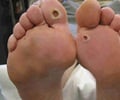
Northwestern Medicine scientists developed a new method that prevented rejection of the islets, a huge problem in transplants between species, called xenotransplantation.
"This is the first time that an interspecies transplant of islet cells has been achieved for an indefinite period of time without the use of immunosuppressive drugs," study co-senior author Stephen Miller, said.
"Our ultimate goal is to be able to transplant pig islets into humans, but we have to take baby steps," Xunrong Luo, M.D., also co-senior author of the study, said
Pig islets produce insulin that controls blood sugar in humans.
For people with hard-to-control type 1 diabetes, a transplant of insulin-producing islets from a deceased donor is one important way to control their chronic disease, in which their bodies do not produce insulin.
Advertisement
Many patients on waiting lists don't receive the transplant or suffer damage to their heart, nerves, eyes and kidneys while they wait.
Advertisement
But concerns about controlling rejection of transplants from a different species have made that approach seem insurmountable until now.
In the new study, scientists persuaded the immune systems of mice to recognize rat islets as their own and not reject them.
Notably, the method did not require the long-term use of drugs to suppress the immune system, which have serious side effects.
The islets lived and produced insulin in the mice for at least 300 days, which is as long as scientists followed the mice.
The study is published online in the journal Diabetes.
Source-ANI















